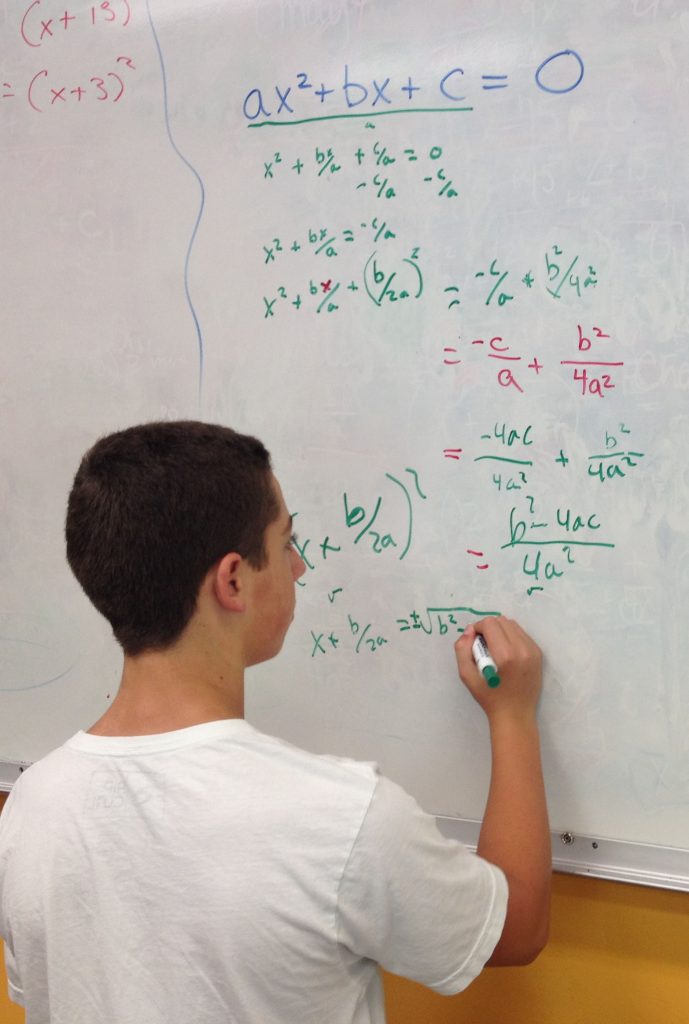Hyla Stories
New Math Program

“The evolution of algebra at Hyla
The story of our new math curriculum begins at the Arbor School soccer exchange. Each year Hyla students compete in various sports events in the region with other students from independent schools. While the soccer exchange with Arbor, Catlin Gabel (track) and Spring Reign (Ultimate Frisbee) are beloved traditions for students, they are also important times for Hyla faculty to connect with other teachers. Casual conversations between teachers at these events can spark exciting exchange and inquiry. And that’s exactly how we came to find out about a new algebra curriculum created at the Arbor School in Oregon. After research and discussion with Head of School Vicki Jenkins, and teachers Paul Carroll, Cindy Schacht, Jeff Steele and Cami Holtmeier, we ran a pilot of the new Arbor algebra program in 7th grade during the 2013-2014 school-year. This year the Arbor algebra program is officially integrated into our curriculum in all grades, and supplemented with integrated math and science work. Head of School, Vicki Jenkins, tells us more about the program:
What is the Arbor algebra program?
It’s a new curriculum for both teaching and learning algebra, designed for all abilities. It was created by Linus Rollman, who believes that we have a fundamental responsibility to the individual student. With this in mind, he created a self-paced program for individualized learning. As a former math teacher, I share this belief.
What’s the difference between the old curriculum and the new one?
A lot stays the same. The former curriculum was extremely effective. The past 20 years of math at Hyla are the foundation that makes this new curriculum even do-able. We knew we wanted to retain some golden aspects of our math program, so we still emphasize deep understanding and conceptualization; we still teach in a social setting where kids take active ownership of their work; and teachers are still facilitators. The main difference between the programs is that Arbor algebra is self-paced.
How does the new model work?
The Arbor algebra program integrates narrative, inductive reasoning, and imaginative problem-solving, on top of common core standards. Kids work in self-paced groups and partner with students who move through material at a similar pace. This type of differentiated instruction allows us a lot of flexibility. This model allows some students to arrive more quickly at math benchmarks and even move into geometry before high school. But it also allows those students who need to take more time with the material to do so. Middle school math happens a bit like the staggered onset of puberty – as kids progress from concrete skills in early elementary math classes to the more abstract world of algebra and beyond, each student’s readiness for that abstraction happens at a different pace.
What are some highlights of the new program?
The multi-modal instruction captures all learning styles. It includes online learning tutorials, active problem-solving, and group discussion. There is also a section called “Notes to Self” where students translate concepts into their own words, which encourages active reading and synthesis of ideas. By translating the concepts into their own words, much like students do in the Shakespeare projects with their retellings, the process itself facilitates a deeper understanding and mastery of the core concepts. The textbook is also exciting. It’s written as a dialogue with students to encourage their own reflection on the concepts.
Why the change?
High quality curriculum isn’t static. It evolves, new options emerge, and we have a responsibility to offer a program that best aligns with our mission and philosophy. As an independent school, we also have the freedom to explore options, integrate them when they are the right fit for our school, and move with more agility through a changing educational landscape. In a time when state standards drive so much of what happens in schools, we are fortunate to offer a program that goes far beyond those state standards – and Arbor algebra does just that. I think this quote from the program’s author, Linus Rollman, says it all: “We should be concerned not simply with imparting skills or knowledge, but with lifting the spirit, with lighting the flame of intellectual curiosity, with opening young eyes to both the wonder and the problems of their world. Algebra…is a key element in this kind of genuine education.”
